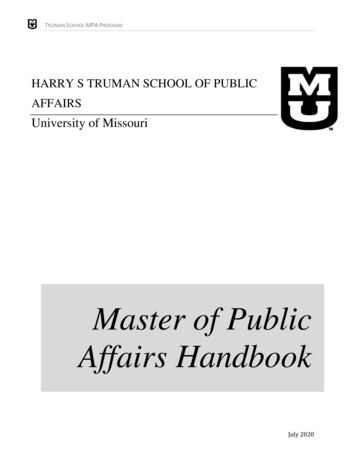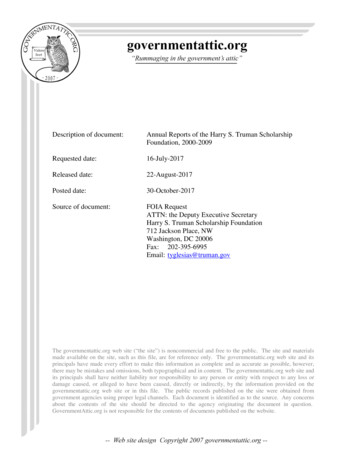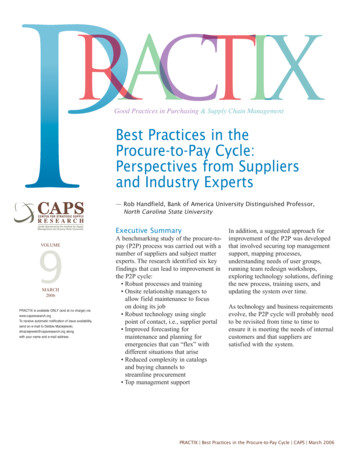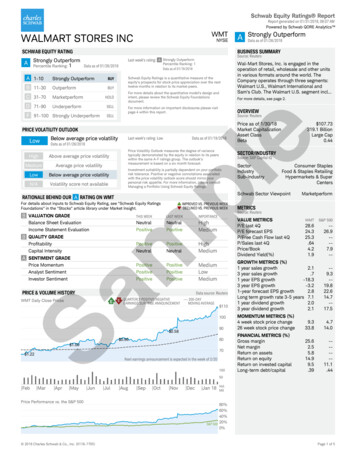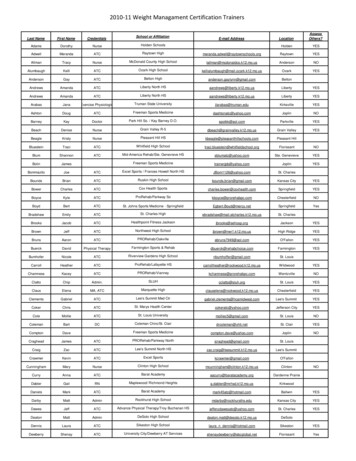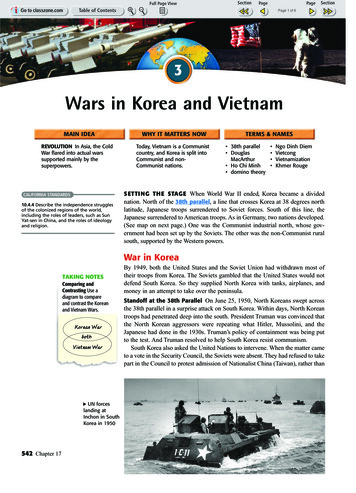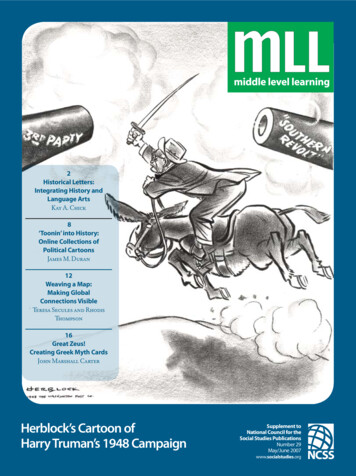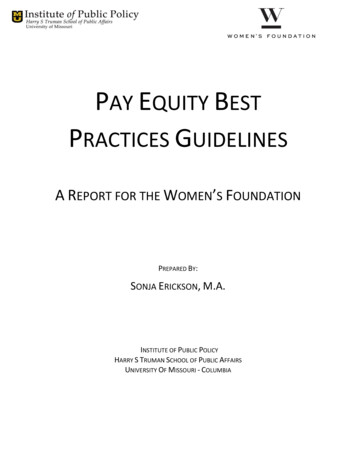
Transcription
PAY EQUITY BESTPRACTICES GUIDELINESA REPORT FOR THE WOMEN’S FOUNDATIONPREPARED BY:SONJA ERICKSON, M.A.INSTITUTE OF PUBLIC POLICYHARRY S TRUMAN SCHOOL OF PUBLIC AFFAIRSUNIVERSITY OF MISSOURI - COLUMBIA
Table of ContentsResearch Note . 2Executive Summary . 3Introduction . 5Pay Gap Facts. 5Equal Pay Laws . 6Equal Pay in Missouri . 7Equal Pay Best Practices. 9Determine if a Gender-Based Pay Disparities Exist. 9How Other States Have Implemented This Practice . 13Application in Missouri . 14Policy Considerations . 15Indicators . 15Re-Evaluate the Current Pay System from an Equity Perspective . 15How Other States Have Implemented This Practice . 16Application in Missouri . 17Policy Considerations . 19Indicators . 19Promote and Ensure Pay Transparency . 20How Other States Have Implemented This Practice . 21Application in Missouri . 21Policy Considerations . 22Indicators . 23Conclusion . 23Page 1 of 25
Research NoteIn 1963, both the federal Equal Pay Law and Missouri’s Equal Pay Act were written toensure equal pay for women in certain types of jobs who perform exactly the same work asmen. Over five decades of research shows that current laws have been unsuccessful atclosing the gender pay gap because “equal work” is difficult to measure for many jobs,especially professional and managerial positions. Instead, employers should seek ways toachieve gender “pay equity,” with pay rates that reflect the internal and external value eachposition and worker brings to an organization. Making the distinction between “equal pay”and “pay equity” is an important step in closing the gender pay gap, so the best practicesincluded here will focus on pay equity, rather than equal pay.Page 2 of 25
Executive SummaryIn 2015, the Women’s Foundation contracted with the University of Missouri’s Institute of PublicPolicy to conduct research on best practices for reaching gender pay equity in Missouri. Thisinformation was used to develop a preliminary report of three best practices for employers inthe public and private sector in Missouri, which became part of Missouri Executive Order No. 1509. The order directed employers to: determine whether gender wage gaps exist in theirorganizations; re-evaluate their current compensation system for pay equity; and ensuretransparency concerning organizational compensation policies.1 This report provides a morecomprehensive study of these best practices, fulfilling the directive of the executive order. Thefindings of this report are summarized below.Employers should determine whether gender-based wage disparities exist in theirorganizations.Employers should conduct self-audits to evaluate whether their compensation practicespromote gender pay equity.Quantitative self-audits include analyses of pay by job title, pay band, or department toidentify gender-based pay disparities.Qualitative self-audits guide employers through open-ended questions to determine if theircompensation practices promote pay equity.Employers should be accountable for completing self-audits and working toward remediatingany gender pay disparities identified during this process.Employers should evaluate whether their current compensation system is equitable.Compensation systems should be evaluated from a gender equity perspective which goesbeyond the concept of “equal pay for equal work.” Instead, the goal should be to understandwhat constitutes fair pay for all workers.Employers should use a standardized methodology to assess the internal and external valueof each position in their organization. Pay rates should reflect the value of every positionregardless of the type of work or job title.Employers should consider non-wage compensation, such as opportunities available to parttime workers, and flexible scheduling, in an evaluation of equal pay practices.Employers should ensure transparency concerning organizational compensation policies.Salary ranges for all job titles should be made public and available to all job applicants.Employers should develop and implement policies which prohibit pay secrecy and eliminatepenalties for discussing pay.Employers should consider joint evaluation processes when making pay raise and promotiondecisions, and ensure that these decisions are justifiable and well documented.Page 3 of 25
For each best practice, this report includes: a summary discussion of the practice and how it canhelp close the gender pay gap in either the public or private sector; examples of how other stateshave followed the best practice; how the best practice can be applied to state of Missouriemployees; state policy considerations; and possible indicators for measuring whether the bestpractice is shrinking the gender pay gap.Page 4 of 25
IntroductionIn 2015, the Women’s Foundation contracted with the University of Missouri’s Institute ofPublic Policy to conduct research on best practices for reaching gender pay equity in Missouri.The Institute conducted an extensive literature review of research related to gender pay equity,and evaluated the programs of other states and municipalities which have recently enactedgender pay laws. This information was used to develop preliminary guidelines of best practicesfor employers in the public and private sector in Missouri.These preliminary guidelines became part of Governor Jay Nixon’s Executive Order No. 15-09,which directed Executive Branch agencies, and encouraged private sector employers, to reviewand determine how these practices can be used to identify and address any gender-based wagedisparities. This executive order also included a directive for the Institute of Public Policy todevelop a more comprehensive report of Pay Equity Best Practices Guidelines to be completedby Equal Pay Day in April, 2016. This report fulfills that directive.Pay Gap FactsBy now the statistics are well known. Regardless of occupation, women working in Americaearn less money than men. This income disparity crosses all racial and ethnic groups,educational levels, and most occupations. The wage gap is quantified by using an income ratio,which measures the gap in earnings between the sexes. In the United States in 2013, themedian income of male wage and salary workers who worked full-time and year-round was 50,033, compared to 39,157 for women.2 This equals an income ratio of 0.78. In simpleterms, this means that full-time, year-round female workers earned 78 percent of what menearned, creating a “wage gap” between the incomes of men and women. The ideal ratio is 1.0,or 100 percent, which signals income parity between men and women.In Missouri in 2013, women who worked full-time and year-round earned only 77 percent asmuch as men. All female workers, including both part-time and full-time, earned only 65percent of their male counterparts. This disparity in wages negatively impacts short-termearnings, long-term savings, retirement benefits, and wealth accumulation.Research shows that many complex factors have created this disparity. For example, becausetwo-thirds of minimum-wage workers are women, annual wage income for all women is lowerthan for all men. Also, female dominated professions, such as care-giving and hospitality, areoften associated with lower wages than male dominated professions, such as engineering andcomputer science. Even becoming a mother has been shown to have a detrimental effect onwomen’s wages, due in part to the number of women who leave the workforce or reduce theirwork hours to meet their care-giving responsibilities. Studies have found that employers areless likely to hire women with children, and to pay lower salaries to those mothers who arehired, while men who become parents do not experience a similar pay penalty.3While educational attainment, career fields, and personal choices can contribute to differencesin income, studies which control for divergent life paths have found that, all things being equal,women still are paid less than men for the same work. A significant disparity exists betweenPage 5 of 25
the wages of men and women regardless of age, race or ethnicity, educational level, andprofession, which suggests that a gender bias exists. For example, women 35 years and olderexperience larger pay gaps than do women in their twenties and early thirties, which could bedue to women leaving full-time, paid work during their childrearing years. This does not,however, explain the gap between the wages of men and women at the start of their careers,which is currently 10 percent.4Equal Pay LawsThe effort to use legislative tools to ensure equal pay for women has been ongoing for morethan 100 years, starting when women began entering industrial jobs in the late 19th century. In1898, the federally appointed Industrial Commission started advocating for equal pay forwomen working the same factory jobs as men. During World War I, when women’s labor wasvital to the war effort, the National War Labor Board (NWLB) mandated that, if women mustundertake work normally done by men, they should earn equal pay for that work. Similarly,during World War II, the War, Navy and Labor Departments required that wage rates forwomen and men be the same, and in 1945, the NWLB issued an “equal pay order,” whichallowed companies to raise women’s wages to equal those of men without having to obtainapproval from the NWLB.The right of women to be paid the same wage as men for equal work became federal law in1963 with the passage of the Equal Pay Act, which amended the Fair Labor Standards Act (FLSA)of 1938. Due to resistance in Congress, the Equal Pay Act passed only after several importantstandards had been removed. One of the most significant was changing the original fairnessstandard from “work of comparable character” to “equal” work, which was narrowly defined.The Equal Pay Act was subject to all FLSA exemptions, which meant that women employed inprofessional, executive and administrative positions were exempt from the act, as were womenworking in certain industries, including hotels and restaurants. Also, class action lawsuits wereprohibited, placing the burden of proof on each individual woman claiming wagediscrimination. 5Several federal laws and executive orders have been passed since the Equal Pay Act of 1963 tohelp address gender based wage discrimination in the work place:Title VII, Civil Rights Act (1964) – Prohibits pay discrimination based on worker’s race,religion, sex or national originTitle IX of the Education Amendments Act (1972) – Prohibits pay discrimination basedon sex at educational institutions which receive federal funding; removed “white collar”exemption from Equal Pay Act (did not modify “equal work” standard)Pregnancy Discrimination Act (1978) – Amended Title VII to prohibit employmentdiscrimination, including compensation, based on pregnancyPage 6 of 25
Civil Rights Act (1991) – Amended Title VII to allow plaintiffs who sue for paydiscrimination to receive compensatory and punitive damagesLilly Ledbetter Fair Pay Act (2009) – Amended Title VII to codify the concept that eachpaycheck containing discriminatory compensation is a separate violationFair Pay and Safe Workplaces Executive Order (2014) – Requires that federalcontractors publish wage data by sex and race to ensure compliance with equal paylawsEqual Pay in MissouriThe Missouri Equal Pay Act was passed in 1963. This statute reflects the language of the federalEqual Pay Act, requiring that equal pay be based on “the same quantity and quality of the sameclassification of work.”6 This act gives employees the right to file a complaint with the Laborand Industrial Relations Commission of Missouri if she has been paid lower wages due to hersex, and to file a civil action to receive compensation for unequal pay. As with the federal EqualPay Act, the woman bringing the claim must prove that the pay discrimination was based on sexand not on any other differences. Missouri also passed the Missouri Human Rights Act in 1986,which prohibits employers from compensation discrimination based on race, color, religion,national origin, sex, ancestry, age, or disability.7The majority of Missouri state employee pay categories are created and regulated by guidelinesestablished in Chapter 36.031 of the Missouri Revised Statutes and Division 20 (1-6) of theMissouri Code of State Regulations (CSR).8 State pay and classification categories generallyoperate under the direction of the Office of Administration, the Director of Personnel, and thePersonnel Advisory Board. Workers employed by Missouri state government fall into one ofthree classification and pay systems: Uniform Classification Pay (UCP) system merit; UniformClassification Pay (UCP) system non-merit; and non-UCP, non-merit.9 As of December, 2015approximately 66 percent of state of Missouri employees worked in the UCP pay system (eithermerit or non-merit). The remaining 33 percent worked outside of that system in non-UCP, nonmerit job titles.Merit Uniform Classification Pay (UCP) System Agencies –These agencies must followall policies set by the Office of Administration Division of Personnel for jobclassifications; salary ranges; and hiring, promotion, and separation practices. Merit jobclassifications and pay bands are developed by the Division of Personnel and approvedby the Personnel Advisory Board.Employees must apply for UCP positions through the State of Missouri Merit ElectronicApplication System (EASe). The EASe system is essentially a database of all applicantswho have expressed an interest in one of the job titles within the state merit system.For example, a prospective employee interested in being hired as an Accounting Clerkcompletes an online application for that job title (as opposed to a current job opening atPage 7 of 25
a specific agency). Based on the work experience and education of the applicant, theEASe system assigns her or him a score, and that applicant is placed on a register of allapplicants for the Accounting Clerk job title.When a merit agency has an opening for an Accounting Clerk, the hiring departmentrequests a “certificate” from the Division of Personnel, which is generated from theAccounting Clerk register, and is a list of all of the applicants for that job title who havescored well enough to be considered for hire. The hiring department then “works thecertificate,” by sending out letters to applicants to determine interest for the openposition in the hiring department. Once the hiring department has narrowed theapplicant pool on the certificate, it returns the certificate to the Division of Personnel,where the list is culled further to select candidates to interview. The hiring departmentthen conducts the interviews and makes the hiring decision.Non-Merit Uniform Classification Pay (UCP) System Agencies – State agencies,departments and positions in the non-merit UCP system are required to follow the meritsystem’s classification and pay ranges, but do not have to follow its hiring, promotion,and separation practices. These agencies do not post position openings through theEASe system, and applicants do not have to apply through that system. Prospectiveemployees can submit their applications directly to these agencies, which are free tofollow their own hiring process. Non-merit UCP agencies do, however, have to followthe same job classification system and pay bands as the UCP merit system. If a nonmerit UCP agency is unable to find a candidate on its own, it can access the applicantpool from the EASe system by requesting a position certificate from the Division ofPersonnel’s register for that position, but they can conduct the rest of the hiring processindependent of the Division of Personnel.Non-Merit & Non-UCP agencies –These agencies are not required to follow any UCPsystem guidelines for hiring, promotions, separations, or position classifications, andare not required to follow Division of Personnel merit system pay ranges. Non-meritand non-UCP agencies do not pull their candidates from the applicant pool in the EASesystem but instead advertise for, select, and hire employees on their own. Pay bandsare not required to be uniform or publicly available, nor are these agencies required topublish salary ranges with job announcements.Per the Missouri Equal Pay Act, it is illegal for an employer to pay a female worker less than amale worker “for the same quantity and quality of the same classification of work.”10 While thislaw was passed to ensure that women receive equal pay for equal work, determining whatconstitutes equal work is complicated. Also, if a woman learns she is being paid less than amale peer, she must be able to prove that she has been paid lower wages are due to her sex,and not any other reason, such as a “difference in seniority, length of service, ability, skill, [or]difference in duties or services performed.”11Page 8 of 25
This standard of proof is often impossible to meet. By placing the burden of proof on theemployee, current equal pay laws provide little incentive for employers to ensure that men andwomen are paid equally. However, there are many reasons that employers should institute agender-neutral compensation system:Ensuring that men and women are paid according to the skills, experience andresponsibility required by their position allows employers to protect themselves fromlitigation that could stem from violating current equal pay laws.Paying men and women equally engenders trust between management and workers,creating a positive work environment which contributes to a highly motivated workforce.Eliminating wage discrimination is an important way for employers to attract and retainthe best workers regardless of their gender, and to remain competitive in the 21st centuryeconomy.There are several best practices which can be implemented by public and private sectoremployers in Missouri to help move the state toward pay equity for all workers.Equal Pay Best PracticesThe Equal Employment Opportunity Commission defines a best practice for the workplace asone that allows employers to comply with the law; promotes equal employment opportunityand fairness to all employees; addresses any barriers to equal employment opportunity;addresses management accountability for equal employment opportunity; and is implementedconscientiously and produces noteworthy results.12 Once implemented, a best practice shouldalso achieve results that are measurable and can be achieved with a reasonable amount ofresources and time.13The following best practices for achieving gender pay equity meet these standards. 14 All usedata that is readily accessible within the state of Missouri’s classification and pay systems, orwithin individual Executive Branch agencies, and should not create undue administrativeburdens. The long-term indicator for each of these best practices is that the state of Missourishrinks the gender pay gap.Best Practice: Employers Should Determine if Gender-Based Pay Disparities ExistIn order to determine whether an organization’s compensation policies are equitable for menand women, management must determine if there is a difference in what they pay male andfemale employees. While the gender pay gap is often represented as a simple comparisonbetween what women and men earn, measuring whether an individual organization pays menand women equally is a more complex process which can yield valuable managementinformation. Such an assessment can shed light on many indicators of pay equity, includingPage 9 of 25
whether the current workforce composition reflects the available candidate pool; whethermanagement includes a proportional balance of men and women; and whether men andwomen are paid equally for performing the same work. This information empowersmanagement to begin to redress any inequities found.An important step to identifying gender-based pay disparities is for management to conductpay equity “self-audits” on a regular basis to ensure that women, as a group, are not paid lessor more than men. These audits should be designed to capture aggregate data rather than toidentify pay disparities between individual workers. A pay equity self-audit must take intoaccount a number of variables, including the size of the group being analyzed, turnover, andyears of service and experience of employees.Management can conduct broad, organization-wide pay equity audits, or more focused audits,such as by department, position title, or pay grade. Such audits can be conducted through aninformal process for internal use by management. Alternatively, self-audits can follow a moreformal, structured process that includes a reporting component and designated oversight body,which can promote accountability and consistency across departments. Both encouragemanagement to take responsibility for pursuing equitable compensation practices.There are several approaches that management can take to identify gender-based paydisparities. Managers can conduct a broad analysis by pay band or job title across anorganization; conduct similar analyses more narrowly at the individual department or divisionlevel; or individual managers can evaluate their own approach to establishing compensationpractices and policies.15Determine if jobs are segregated by gender. Job segregation refers to any situationwhere a job title is completely held by either men or women. Similarly, a genderdominated position is one in which a significant majority of workers are either male orfemale. Having positions that are either gender-segregated or gender-dominated canplay a large part in creating a gender-based pay disparity if lower paying positions aredominated by one gender while higher paying positions are dominated by the other.For example, if office support staff positions in an organization are largely or entirelyheld by women while management positions are largely held by men, that organizationwill likely have a gender-based pay disparity.Analyzing the job titles in an organization to determine the gender composition of eachcan provide management with a quick assessment of where and why pay disparitiesmight exist. However, the value of such an analysis is dependent on the number ofpeople who hold the job title. For example, if 100 people work in a given position and75 of them are women, that position should be considered gender dominated. If fourpeople work in a given position, and three of them are women, this is not a meaningfulindication of gender segregation. Therefore, assessing whether any positions aresegregated by gender can yield important information about pay differences betweenmen and women, but should be seen as a first step to a more in-depth self-audit. ThisPage 10 of 25
type of assessment can be done broadly across an organization, or more narrowly bydepartment or division.Conduct a pay equity analysis by job title. Management can also analyze whether agender pay disparity exists within individual job titles. When workers are grouped bytitle but divided by gender, management can quickly evaluate whether there is asignificant difference in pay between women and men working in the same position.This approach can also help control for variables such as education or experiencerequirements, as everyone hired into a given position presumably comes with similarqualifications.As with measuring gender-based job segregation, however, analyzing for gender paydisparities by job title has some limitations. For example, if an organization does havewidespread gender segregation, an analysis by job title cannot produce meaningfulinformation because pay rates for individual positions cannot be evaluated by gender.Also, any given position must be held by enough employees to yield a representativecomparison. Finally, within any given job title there may be variation between thetenure of individual workers, which can have a significant impact on pay rates. Despitethese caveats, analyzing men’s and women’s pay by job title is a broad method whichmanagement can use to identify, and begin to remediate, gender-based pay disparitieseither across an organization, or within individual divisions or departments.Conduct a pay equity analysis by pay band. A more robust approach to determiningwhether an organization has gender-based pay disparities is to evaluate men’s andwomen’s salaries within an individual pay band. Common among public sectoremployers, pay bands are used to guide managers’ compensation decisions by groupingpositions requiring similar skills, education, and responsibilities into a salary range. Paybands are comprised of positions requiring similar skill levels, but are not necessarily allsimilar positions. Because positions within a pay band share similar skill-levelrequirements, men’s and women’s pay should be equitable within any given pay band.Conducting an analysis by pay band can indicate a true wage disparity at any given levelin the compensation system.An analysis by pay band can be used in conjunction with a job segregation analysis toreveal possible gender-based pay disparities. Dividing pay bands by the number of menand women who work in those bands can quickly show whether an organization has asignificant number of gender-segregated or gender-dominated pay bands. Thisinformation can also help management determine whether a ceiling exists in theorganization where one gender becomes significantly underrepresented as the paybands increase.As with pay analyses by gender segregation and job title, this approach can be usedbroadly across an organization or more narrowly within individual departments orPage 11 of 25
divisions. However, such an analysis might yield more useful information at thedepartment or division level, where more detailed data, such as years of service of eachemployee, can be considered to rule out discrepancies which are not gender-based.Armed with this information, managers can investigate pay bands or job titles with paydisparities to determine whether those disparities are due to gender, or can beexplained by other factors, and can begin to redress inequities.In January, 2016, the federal government took executive action to encourage the privatesector to gather the data necessary to conduct a pay disparity analysis by pay band. TheEqual Employment Opportunity Commission (EEOC), in partnership with theDepartment of Labor, published a proposal to collect summary pay data by gender, race,and ethnicity each year from businesses with 100 or more employees. Pay would bereported across 10 EEOC job categories and by 12 pay bands. This proposed changewould expand the data currently collected by the EEOC through its EEO-1 compliancereport, with a goal of improving enforcement of federal pay discrimination laws andsupporting voluntary compliance with those laws.16Use a self-audit tool to assess all compensation practices. While the previous self-auditmethods focus on assessing differences in pay between male and female workers,another approach to conducting a pay equity self-audit asks employers to assess wagesetting policies to ensure that they are fair and applied consistently for all workers.There are several self-audit tools designed to help employers conduct a guidedexamination of how hiring, pay and promotion decisions are actually made, and toidentify any areas where compensation practices disadvantage women.One such tool, developed by the Business and
achieve gender "pay equity," with pay rates that reflect the internal and external value each position and worker brings to an organization. Making the distinction between "equal pay" and "pay equity" is an important step in closing the gender pay gap, so the best practices included here will focus on pay equity, rather than equal pay.

